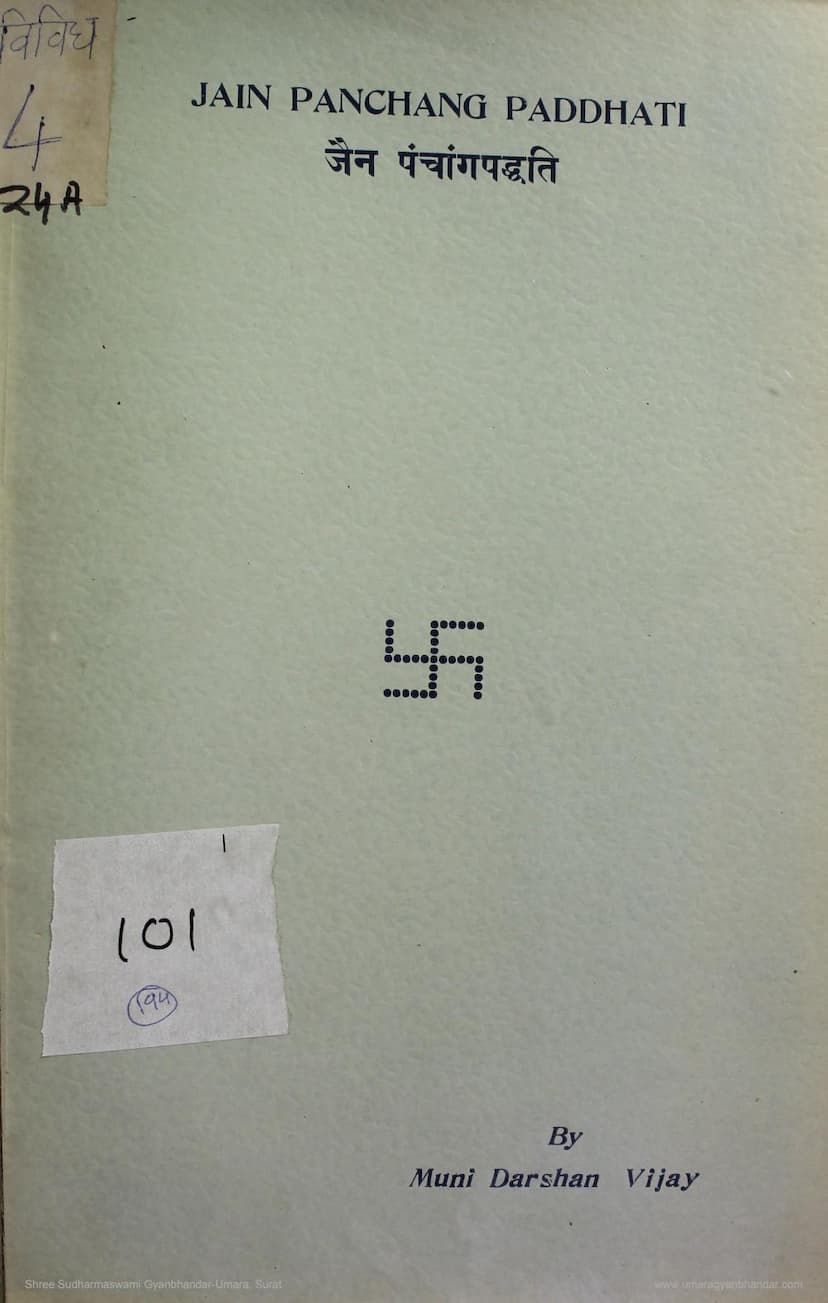Jain Panchang Paddhti
Added to library: September 2, 2025

Summary
This Jain text, "Jain Panchang Paddhti" by Muni Darshanvijay, published by Shree Charitrasmarak Granthmala, is a comprehensive treatise on the Jain calendar system. The book delves into the intricacies of calculating and understanding the Jain calendar, which is crucial for determining auspicious timings for religious observances and festivals.
Key themes and content of the book, as evident from the provided pages, include:
-
Introduction to the Jain Calendar System: The book begins by explaining the foundational principles of the Jain calendar, likely discussing its celestial basis and how it differs from other calendar systems. It addresses the historical context and the necessity of a precise calendar for Jain practices.
-
Debate on Calendar Practices: A significant portion of the introductory sections (pages 4-5) highlights a contemporary debate within the Jain community regarding the correct observance of certain festivals, particularly Samvatsari. This discussion involves differing interpretations of ancient texts and practices, leading to the formation of two opposing factions. The author positions himself within this debate, advocating for the preservation of traditional practices based on his extensive study of Jain astrological and calendrical scriptures like Surya Prajnapti, Chandra Prajnapti, and Lokaprakash.
-
Types of Years and Months in Jainism: The text details various types of years and months recognized in Jain cosmology and calendrical calculations. This includes:
- Nakshatra Samvatsar (Lunar Mansion Year): Based on lunar mansions.
- Chandra Samvatsar (Lunar Year): Based on the lunar cycle.
- Ritu Samvatsar (Seasonal Year): Based on seasons.
- Aditya Samvatsar (Solar Year): Based on the sun's movement.
- Abhivardhit Samvatsar (Augmented Year): Likely referring to intercalation or compensatory measures. The book elaborates on the durations and interrelations of these celestial cycles, emphasizing their significance in determining festival dates and timings.
-
Avama Ratra (Deficient Night) and Atira Ratra (Excess Night): A considerable part of the text is dedicated to explaining the concepts of "Avama Ratra" (deficient night) and "Atira Ratra" (excess night) as they relate to the lunar and solar calendars. These concepts are crucial for understanding intercalary months and days necessary to synchronize the lunar and solar cycles and are explained with reference to specific verses from Jain scriptures like Sutra Krutasutra and Bhagavati Sutra.
-
Critique of Modern Calendars: The author critically examines modern or "Laukik" (worldly) calendars, highlighting perceived deviations from ancient Jain principles. He argues that the introduction of concepts like "tithi vruddhi" (tithi increase) and "masa kshaya" (month decrease) in these modern calendars leads to inaccuracies and deviations from true Jain practices. He contrasts the fixed nature of ancient Jain calculations with the perceived flexibility and potential inaccuracies of newer systems.
-
Importance of Udaya Tithi (Sunrise Tithi): The book emphasizes the significance of "Udaya Tithi" (the tithi present at sunrise) as the determinant for religious observances. It explains how this principle is applied, even when tithis shift or overlap, and discusses the exceptions and interpretations thereof.
-
Debate on Interpretation and Practice: The text highlights the author's engagement with contemporary debates, particularly with the views of Muni Kalyanvijayji and others. Muni Darshanvijayji strongly refutes their interpretations, asserting the validity and superiority of the traditional practices based on his scriptural research. He argues that deviations from traditional practices, especially concerning festival dates and observances, are not supported by authentic Jain scriptures.
-
Examples and Scriptural References: Throughout the book, the author cites numerous references from various Jain scriptures, commentaries, and historical texts (like Surya Prajnapti, Chandra Prajnapti, Lokaprakash, Shraddha Vidhi, Hir Prashna, Sen Prashna, Tatva Tarangini, etc.) to support his arguments and refute the opposing viewpoints.
-
Focus on Samvatsari and Other Festivals: The book specifically addresses the timing of important festivals like Samvatsari, discussing how the debate on tithi adjustments impacts their observance. It also touches upon the observances related to other festivals and auspicious days.
In essence, "Jain Panchang Paddhti" is a scholarly work that aims to:
- Preserve and propagate the correct understanding of the Jain calendar.
- Defend the authenticity of traditional Jain practices against perceived deviations.
- Provide scriptural and logical arguments to support the author's position in the ongoing community discourse.
- Educate readers on the complex calculations and principles underlying the Jain calendar.
The book seems to be written from a perspective that strongly advocates for adherence to established ancient Jain traditions in calendrical matters, directly engaging with and countering interpretations that deviate from these traditions.